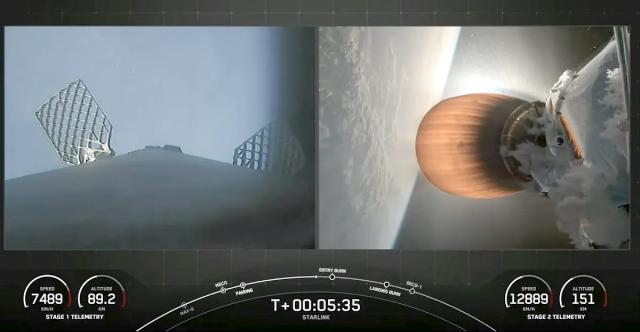Falcon 9 Block 5 gave a partially unsuccessful flight for the first time in three hundred launches. The rocket was launching 20 SpaceX satellites, communication has already been lost with 15, and five more may be lost in the near future.
Today, July 11, at 5.35 am Moscow time, the Falcon 9 rocket took off for the 70th time in 2024 (Russia has so far made only eight space launches this year). In this particular launch, the first stage was used, which had already completed 18 flights before. But although it worked fine (and successfully landed on the platform), the second stage of the rocket could not work properly. The restart of her Merlin Vacuum engine failed. The reasons for this are not yet completely clear.
Due to problems with the second activation, the second stage was unable to bring 20 Starlink satellites into the planned orbit. The company managed to contact only five out of 20, and now it is trying to put them into the highest possible orbit due to the low-power engines of the satellites themselves. The chances of success of this event are not obvious. 13 of the 20 satellites launched by the rocket this time had a Direct to Cell function, that is, they could provide Internet not through a Starlink dish, but directly to the user's mobile phone.
What happened is very unusual, because the Falcon 9 is the most reliable rocket in the history of mankind. Today, she has 364 flights, only one of which (in 2016) ended in complete failure (loss of the rocket and payload). Two more ended partially unsuccessfully: the SpaceX CRS-7 mission in 2012 and today's flight. In both cases of partial failures, the rocket missed the payload to the desired orbit. The launch on July 11, 2024, interrupted the chain of 344 trouble-free launches of the Falcon 9. It was the longest chain of trouble-free launches in the history of mankind. Taking into account today's partial failure, the proportion of fully successful Falcon 9 launches fell to 99.18% (3 cases out of 364 launches).
For comparison, it can be pointed out that the Soyuz-U rocket (the most massive in launches today) had 22 emergency flights for 795 (97.3% reliability), the Russian Proton-M (began flying in 2001) had 10 incomplete launches for 115 (91.3% reliability). Despite the fact that the reliability of SpaceX rockets looks very good against the background of competitors, what happened is very unpleasant for the company itself. Specifically, this modification of its rocket (Falcon 9 Block 5) has not had even partial failures so far.
One of the reasons for the high reliability of the rocket is the specific ideology of its design. The first stage was deliberately made multi-engine, with the same idea that was behind Korolev's decision on the multi-engine capability of the Soviet lunar rocket N-1 (a large number of engines of the first stage can provide output even if one of the engines worked abnormally). The Falcon 9 has already had cases when some first-stage engine failed, but due to the work of the rest, the rocket nevertheless brought its payload into an orbit acceptable for further work. However, the Falcon 9 does not have multi-propulsion in the second stage (unlike the second stage of Starship or the royal H-1, for example), so there was nothing to compensate for today's anomaly in the operation of the second stage engine.
At the same time, what happened is unlikely to be partially reusable: the first stage of the rocket worked normally, and the second stages of the Falcon 9 are disposable, that is, always new production. A number of industry observers have already noted that in today's flight, just a couple of minutes after the first start of the second-stage engine, an unusually large amount of frost began to form. Although ice is always formed at the second stage in such circumstances (due to the discharge of part of the liquid oxygen), but today it was definitely significantly more than usual. That is, it cannot be excluded that there was a leak from the liquid oxygen tank this time. This may explain the failure on the second power-up.

